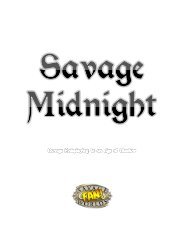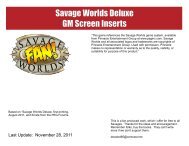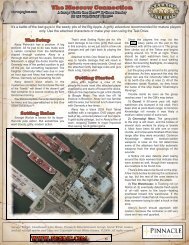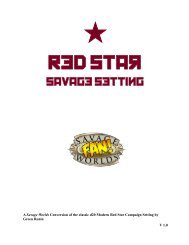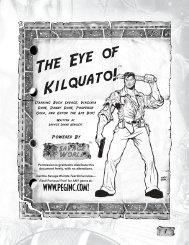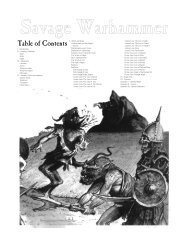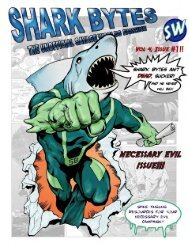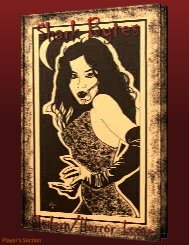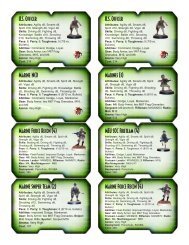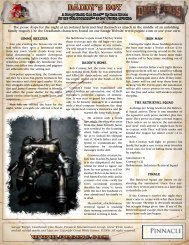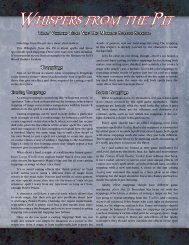IN THIS ISSUE: - Savagepedia
IN THIS ISSUE: - Savagepedia
IN THIS ISSUE: - Savagepedia
Create successful ePaper yourself
Turn your PDF publications into a flip-book with our unique Google optimized e-Paper software.
Regions: The Savaged Redline world is divided into three main types of geographical regions—wastelands, ruins, and<br />
green zones. Wastelands are the dry, dead regions that wouldn’t be worth visiting if it weren’t for all the fuel found there.<br />
Ruins are all that’s left of the great cities, full of salvage and crawling with mutants. Green zones are hidden paradises with<br />
plenty of food and water—as well as xenophobic Savages and strange mutated creatures.<br />
Wastelands are desolate, lonely regions of shifting sands, stony soil, and endless plains. The inexperienced traveler is<br />
easily lost because of the lack of landmarks. The ground is crisscrossed with cracks and dotted with strangled cacti and<br />
bits of greenery. Tiny creatures feed on the greenery; they in turn are fed upon by larger creatures that also feed on<br />
humans when they get the chance. The climate is hot and arid—between the blazing sun and the howling winds; the<br />
wastelands can suck a traveler dry within a day or two. Sand storms, Creep clouds, sinkholes, and the ever-present<br />
threat of dehydration are just a few of the challenges that await the traveler entering these regions. Potable water is<br />
scarce everywhere—even more so in the wastelands. A few ancient wells and the rare rain shower are the only sources<br />
of clean water in this burning desolation. Food is just as scarce, and the local animals are as likely to eat you as you<br />
are to eat them! What the wastelands lack in water they make up for in fuel. In isolated compounds across the region,<br />
oil derricks and refineries pump away day and night churning out gasoline for survival and profit. Salvage hunters<br />
never know what they will find in the wastelands. They can search for weeks and find nothing, then top a sand dune<br />
and discover an abandoned military base—untouched by the war and ready to be looted.<br />
Ruins are vast, chaotic forests of twisted metal, shattered concrete, and broken glass. They are all that remain of the<br />
once great cities. Because the cities were the primary targets of destruction during the war they are infested with the<br />
Creep—even the “cleanest” cities still have areas that mean certain death if entered. Nevertheless, the ruins are more<br />
densely populated than the wastelands or the green zones. Many live here because they are drawn to the remains of<br />
their once great civilization. Others are descendents of the original city dwellers who survived the war by burying<br />
themselves deep within underground shelters. Others come to the ruins looking to make their fortune in salvage. For<br />
those willing to take the risk, the ruins are an opportunity to strike it rich… or die trying. There is water in the ruins, but<br />
it’s not always safe to drink. Old cisterns, sewers, and water pipes have accumulated water. Whether or not it’s pure is<br />
another story! Oftentimes even the rainwater is tainted, and sometimes it burns the skin as it falls. Food is limited to<br />
what the locals can grow or scrounge from the remains of ancient grocery stores. Fuel is even more limited in the ruins.<br />
Any reserves from before the war (such as those found in fuel station tanks) have long since disappeared and there is<br />
little raw material for making more. The ruins are full of salvage. They’re practically made of salvage, though only a<br />
portion of it is worth anything in trade. Tools, blades, guns, flashlights, and other portable and immediately useful<br />
items are worth a lot anywhere. Beams of wood, sheets of metal, and other raw materials can be profitable as well, but<br />
it’s best to have a paying customer lined up first. Rigger towns, trading posts, and boomtowns typically lay along the<br />
fringes of the ruins.<br />
Green zones are just far enough from the cities to have not only avoided the bombs themselves, but the chaos of the<br />
dark years that followed as well. Mother Nature isn’t dead; she’s just hiding. The world is littered with isolated areas—<br />
none larger than 10 or 20 square miles—that survived the war. The water runs clear in these hidden valleys, plants still<br />
grow, and animals flourish. However, the green zones couldn’t avoid the global devastation altogether. In some areas<br />
the Creep has contaminated the land and twisted the bodies of the creatures into dangerous parodies of what they<br />
once were. Green zones rarely lack clean water. Most are fed by deep running streams and a few, if their geography is<br />
right, even get a decent amount of rainfall. With water comes food. A few green zones naturally produce food in the<br />
form of nuts, berries, and fruit. Most green zone settlements grow small gardens near the water. Some settlements have<br />
small herds of goats or sheep, and most hunt and fish. Fuel and salvage are rarely, if ever, found in the green zones.<br />
The Creep: The bruised and wounded surface of the world bleeds toxic, infectious substances. The myriad of<br />
environmental poisons has mingled to the point that, in regard to modern medicine, they have all become the same global<br />
ailment. To the folks who wander the remains of the world, all of the radioactive goops and lethal pathogens are thought of<br />
as a single plague: the Creep. In truth, the Creep is any effect stemming from radiation, man-made biological agents, and<br />
toxic chemicals. Specific effects vary according to the substance encountered. Most of the thousands of individual toxins<br />
have no names, at least none that anybody remembers, and are either labeled based on their source (e.g. Rad Creep) or<br />
the area where they were first encountered (e.g. Nagshead Creep). The easiest way to handle the Creep in the game is to<br />
treat biological and chemical variants as individual poisons or diseases. Nuclear and radiological variants can be treated as<br />
a single type of radiation. Game effects are handled according to the guidelines for poison, disease, and radiation as<br />
presented in the Savage Worlds rulebook. The creation of individual strains of the Creep and their specific effects is left to<br />
the GM’s imagination.<br />
Shark Bytes #2 - October 2004 44




